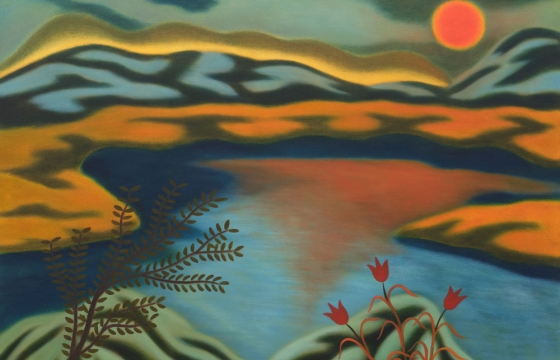Carl Kostyál is delighted to present a new body of work by Swedish-born artist Camilla Engström. The exhibition ‘Ro’, Swedish for tranquility, marks the artist’s debut in London, and her fifth solo exhibition with the gallery.
“Camilla Engström’s recent paintings are inspired by photographs that her father sent her from his walks by the Råcksta lake, a nature reserve close to Stockholm, Sweden. The photographs have functioned as a kind of mood board rather than being directly used as basis for paintings. Now living in California, the artist viewed them with a mixture of comfort and longing. The painting Melting Snow (2024), for instance, depicts a transitional moment that so many Swedes long for, the arrival of spring after months of cold and darkness. But the painting is a not a realistic rendering of a particular landscape. The fields of white, green and blue form abstract patterns, whereas the foreground with flowers and a bare birch tree are more clearly figurative elements.
For other paintings she has also drawn inspiration from her travels along the Californian coast around Morro Bay, Cambria and Big Sur. They are imaginary landscapes conceived as a synthesis of the places she loves. In Morro Bay, a large rock raises out of the sea: Morro Rock is one of several volcanic plugs, remnant of a necks of extinct volcanoes and was considered a sacred site by the Salinan and Chumash tribes. The smoking volcano is a recurring motif in Engström’s paintings. The meandering smoke rising from earth to heaven, is like a sign of life, of something hot stirring under the calm surface. Engström paints nature as animated, a belief that is shared by both romanticism and many religions.
In her paintings, landscapes and flowers are sometimes merged with female bodies, and with the sun as a lactating breast. Portraying nature as sensual, even sexual, her work has been compared to that of Georgia O’Keeffe. There are also several paintings with naked woman reclining in nature, often with closed eyes. In Earth Dreamer (2023) a sleeping nude is laying on her side, arm folded under her head. Locks of her long hair meanders down into the orange, desert landscape and turns into blue streams of water. An earth goddess, perhaps, creating a world in her dreams.
Another source of inspiration are images that comes to mind during meditation – something she does every day. While meditating you shut out all distractions and focus on being present in the moment. This is also necessary when making art. Engström’s work process is intuitive. She doesn’t make preparatory drawings or sketches. She has said that she believes in the healing powers of art, the therapeutic effects both in making and experiencing art. Not least after her stint in the fashion industry, art felt like a haven of freedom and empowerment.
Contemporary landscape painting is often discussed in relation to climate change and environmental crisis. Engström’s paintings could of course be viewed from this perspective – even if the works are free from didactic messages. Rather, she displays a Pop-art sensibility, embracing what the more stern and ascetic parts of the art world might consider too playful and decorative. The environmental engagement is rather to be found in the love of nature, and in showing a world that is worth protecting. A reminder that human beings are both part of and dependent upon the natural world.
The dream-like, otherworldly quality of the works is related to Surrealism, like the enigmatic works of Magritte. There is a serene, utopian feel to them; the dreams they evoke are not nightmarish. But if one looks for art historical references, the post-Impressionist Synthetism movement also seems relevant, with its emphasis on two-dimensional flat patterns and bold outlines and a focus on the artist’s feeling toward the subject. Turning Tides is a vibrant and emotionally charged composition, where the mountains in the distance, shimmering sunlight on the water and an intensely red and green shoreline appear majestic, timeless. A thin branch with a few sprouting leaves in the foreground is contrastingly fragile looking. It captures the paradox of strength, beauty and vulnerability.
The Swedish painter Hilma af Klint is another artist that resonates with Engström. af Klint’s early abstract paintings were part of a spiritual quest. She considered her work to have been guided by higher spirits referred to as The High Masters. Engström has been granted a residency at the soon-to-be reconstructed studio of Hilma af Klint, located on Adelsö, an island not far from Stockholm where the artist spent her summers and painted. The channelling of spirits is also relatable to her: Engström has invented a persona, an alter-ego that she has named Husa, which is Swedish for housemaid. This sounds ironic considering how she is portrayed as an independent, free woman and a kind of eco-feminist, but she says of her “I think symbolically Husa represents Mother Nature or the source of creation in general.” – Magnus af Petersen, 2024


